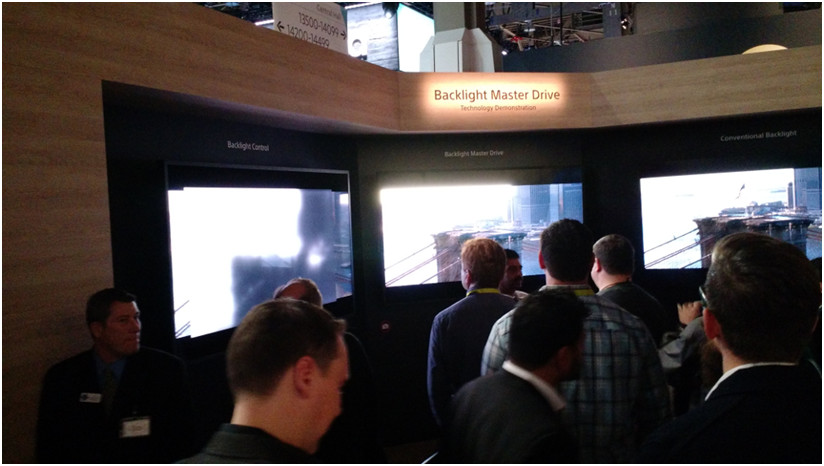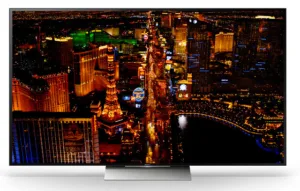At a special Sony press and installer meeting in New York in early February, we had a chance to get some updates and demos of the latest Sony UHD TVs sets. Picture quality was compared in a nice side-by-side demo and pricing was released.

The demo was nicely done. It consisted of Sony’s $30K RGB OLED monitor (BVM 4200) as the reference image (it can go to 1000 nits). Above it were three commercial UHD TVs – all getting the same signal. The TVs consisted of the LG EF9500 OLED, Sony 940D LCD and Samsung 9500 SUHD LCD – all in 75” class screen sizes.
As expected, the LG set had the best black level but was quite comparable to the reference monitor levels in the dim room. The LCDs were able to create high peak luminance levels, so essentially shifted their contrast capabilities to a higher luminance range.
The choice of OLED or LCD really comes down to how you watch TV. If you prefer dark or dim environments, then the OLED will likely offer better value, while in a brighter room, the punch of the LCD would be better with the higher black level not really noticeable.
As for colors, there were noticeable differences. The one piece of content that really showed this off was a clip from Carnival. Here, there were objects that had a gold color in the reference monitor that were decidedly copper-colored in the Samsung and LG sets, but closer to gold in the Sony TV. All sets were set up in the out-of-box mode, but overall, the Sony set did mirror the reference monitor the best, meaning the company is doing a really good job of maintaining image quality across its product lines.
The screen sizes and pricing for these HDR/WCG capable UHD TVs from Sony is shown in the table below. They should start shipping this spring.
| Model | Price (SRP) | Sizes |
| XBR-X850D | $2,499.99, $3,499.99, 4,999.99, $9,999,99 | 55” class, 65” class, 75” class, 85” class |
| XBR-X930D | $3,299.99, $4,999.99 | 55” class, 65” class |
| XBR-X940D | $7,999.99 | 75” class |
Starting in 2016, Sony 4K televisions that are capable of fully taking advantage of HDR content, from the XBR-X850D series and up, will be branded with a new “4K HDR Ultra HD” logo. Logoed televisions meet the Consumer Technology Association’s (CTA) HDR definition and support compelling next-generation visual experiences.
This logo is NOT the same as the Premium logo being developed by the UHD Alliance and adopted by many industry participants. Sony is unlikely to adopt the UHDA certification program – even though it says the sets meet the specifications. Apparently, Sony wants the 4K HDR Ultra HDR branded to be used across Sony’s 4K HDR Ultra HD compatible products from content production, to display devices and services – a bigger branding play.
Only the 940D is a direct backlight type unit. However, Sony says the X930D can create very good HDR using an edge-lit design as well. They call this Slim Backlight Drive which they say is based on a “grid lighting” design. It would appear to be a version of their “Backlight Master Drive” technology that was demonstrated at CES in a 4000 nit prototype.
The X850D models are edge-lit as well, but do not implement the Slim Backlight design concept. Instead, they appear to use a full frame type dimming drive.
The 4000 nit prototype, called “Backlight Master Drive”, was shown at CES to gather feedback on commercialization. The 85” LCD features over 1,000 dimmable zone in the direct array backlight. Sony showed a version of the display with the LCD front panel removed so you could see the modulating backlight. It is just a grayscale image, of course, but it had fairly fine detail in the luminance variation. Haloing is not a problem, claims Sony. This is mainly addressed by increasing the density of LEDs in the direct backlight.

One reporter who saw a private demo quoted Sony as saying, “The work on this [Backlight Master Drive] is done by production engineers. We can almost achieve something that is close to OLED with LCD, so now we’re looking at several different problems: power consumption, the cooling system, as well as cost and size. We’re investigating these now.”
We think the design places LEDs along the vertical and horizontal edges of the display. Each bank of LEDs has a series of segmented light guide strips to confine the light to a narrow width. With the two banks of LEDs, a waffle matrix is formed allowing light to be adjusted at each crossing point to a pretty high degree.
Sony’s image processing engine is called X-Tended Dynamic Range Pro. This is used on the company’s direct backlight type TVs and is used to produce ideal contrast, enhancing HDR and non-HDR content by boosting and dimming the backlight levels precisely for each zone of the screen with a unique backlighting algorithm.
4K X-Reality PRO enhances detail using a unique algorithm from a reality creation database for TV broadcasting, DVD, Blu-ray Disc, Internet video and digital still photos. The 4K Processor X1 improves color accuracy, contrast and clarity of HD, 4K and 4K HDR video.
Wide color gamut models carry the Triluminos name, but Sony does not appear to be using any quantum dot solutions in this line for 2016. Sony is secretive about its specifications and technology, but it is likely to be an RG phosphor approach, perhaps in combination with a color filter modification. Sony told us that their 2015 models achieved 94% of P3, but they think they can get to P3 in 2016. HDR support for 2016 appears to be the basic HDR-10 standard. (CC)

